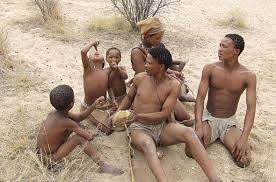Profile
In South Africa there are two main San communities, about 700 Khomani San in the Northern Cape (data: South Africa: Human Rights Commission slams San rights violations, Irin News,7 March 2005) and about 5,000 from the !Xu and Khwe groups brought to the country by the South African army from Namibia and southern Angola following Namibian independence in 1990.
Historical context
The =Khomani are descendants of people evicted from the Kalahari Gemsbok National Park on the borders of South Africa, Namibia and Botswana when it was established in 1931. The =Khomani lodged a land claim under the laws of post-apartheid South Africa and won a landmark settlement from the government. In its first phase, the government returned to the =Khomani 38,000 hectares of farmland for purposes of establishing a novel =Khomani communal farm. After the dispersed population had established mechanisms of self government, in 2001 it entered into negotiations with the government over the second phase of the settlement: land rights in the park, now connected to a national park in Botswana, and collectively named the Kgalagadi Transfrontier Park. The settlement finalized in 2002 granted the =Khomani extensive use of the park for cultural practices, including hunting, and establishment of eco-tourism ventures, as well as various cultural and economic activities in lands near the park..
For over ten years from 1990, the !Xu and Khwe peoples languished in the tent army camp at Schmidtsdrift near Kimberley, almost entirely dependent on army salaries still drawn by some of them. They had been employed mainly as trackers by the South African Defence Forces, during the white-led governments war in the front-line states. Their land claim to the army base was rejected when Tswana peoples successfully claimed it as their ancestral lands. Finally in 1999, the government allocated 13,000 hectares for the !Xu and Khwe at nearby Platfontein. But it took another four years for the government to begin building housing there. By January 2004, however, a new school had been built, as well as houses with running water and electricity for 300 families.
Current issues
In March 2005, the Human Rights Commission issued a blistering report on the government’s treatment of the =Khomani. It cited police involvement in the January 2004 murder of a =Khomani leader, and a failure to provide basic services to this marginalized group. Local government had obstructed development of the communal farm established for the =Khomani in 1999 by failing to provide water, sanitation or waste water treatment.
The =Khomani, Khwe and !Xu communities are still among the most marginalized groups in South Africa, yet the government has made steady advances in acknowledging their rights and grievances, and addressing land claims.
http://minorityrights.org/minorities/san-2/

